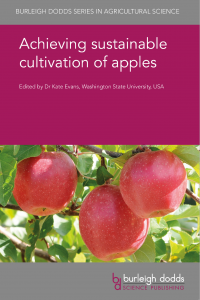
Description
Originating in Central Asia, apples are one of the most important fruits globally and are grown in over 100 countries. Apple cultivation faces a number of challenges. Increasing global competition has put the focus on lowering costs whilst further improving sensory quality and shelf-life. There is a need to reduce inputs such as water, fertiliser and labour, both to save costs and reduce environmentally-damaging emissions and pollution. There is a continual battle with fungal, viral and bacterial diseases as well as insect pests. In the long term there is a need for new varieties able to withstand disease or more extreme conditions associated with climate change. This means preserving genetic variety and exploiting new molecular breeding techniques opened up by the sequencing of the apple genome in 2010.
Drawing on an international range of expertise, this collection focuses on ways of improving the cultivation of apples as a food crop at each step in the value chain, from breeding through to post-harvest storage. The book first reviews research in apple physiology and breeding. The following sections focus on cultivation techniques through to post-harvest storage, followed by a discussion of diseases and pests and their management. Concluding chapters address wider issues such as economics, consumer trends and sustainability
Achieving sustainable cultivation of apples will be a standard reference for fruit and horticultural scientists in universities, government and other research centres and companies producing apples.
Visit the Burleigh Dodds bookstore for sample content and to order your copy.
Key features
- Detailed coverage of the latest research on plant physiology, including flowering and pollination in trees, apple fruit development, and ripening;
- Reviews current best practice in tree training, pruning and thinning operations, including the use of growth regulators and new areas such as mechanisation and automation
- Discusses the range of fungal and viral diseases affecting apples and trends in integrated disease management.
Chapters and authors
* authors from WSU indicated in bold text
Part 1. Plant physiology and breeding
- Ensuring the genetic diversity of apples. Gayle M. Volk, USDA-ARS-CARR National Laboratory for Genetic Resources Preservation, USA
- The apple genome – harbinger of innovation for sustainable apple production. Amit Dhingra, Washington State University, USA
- Advances in understanding apple tree growth: rootstocks and planting systems. Dugald C. Close and Sally A. Bound, University of Tasmania, Australia
- Advances in understanding apple tree growth: the manipulation of tree growth and development. Dugald C. Close and Sally A. Bound, University of Tasmania, Australia
- Advances in understanding flowering and pollination in apple trees. Peter M. Hirst, Purdue University, USA
- Advances in understanding apple fruit development. A.N. Lakso and M. C. Goffinet, Cornell University, USA
- Evaluating and improving rootstocks for apple cultivation. G. Fazio, USDA-ARS/Cornell University, USA
- Advances in marker-assisted breeding of apples. K. Evans and C. Peace, Washington State University, USA
Part 2. Cultivation techniques
- Innovations in apple tree cultivation to manage crop load and ripening. Stefano Musacchi, Washington State University, USA; and Duane Greene, University of Massachusetts, USA
- Advances in soil and nutrient management in apple cultivation. G. H. Neilsen, D. Neilsen and T. Forge, Summerland Research and Development Centre Agriculture and Agri-Food Canada; and K. Hannam, Natural Resources Canada
- Mechanization and automation for apple production. Q. Zhang, M. Karkee and L. R. Khot, Washington State University, USA
- Sustainable approaches to control postharvest diseases of apples. W. J. Janisiewicz and W. M. Jurick II, USDA-ARS, USA
- Advances in postharvest handling and storage of apples. Christopher B. Watkins, Cornell University, USA
Part 3. Diseases and pests
- Pre- and postharvest fungal apple diseases. Wayne M. Jurick II, USDA-ARS, USA; and Kerik D. Cox, Cornell University, USA
- Management of viruses and virus-like agents affecting apple production. Kenneth C. Eastwell, Washington State University, USA
- Bacterial diseases affecting apples. John Norelli, USDA-ARS, USA
- Sustainable arthropod management for apples. Elizabeth H. Beers, Washington State University, USA
- Advances in pest-resistant and disease-resistant apple varieties. Markus Kellerhals, Agroscope, Switzerland
Part 4. Sustainability
- The economics of apple production. R. Karina Gallardo, Washington State University, USA; and Hildegard Garming, Thünen Institute of Farm Economics, Germany
- Consumer trends in apple sales. Desmond O’Rourke, Washington State University and Belrose Inc., USA
- Assessing the environmental impact and sustainability of apple cultivation. D. Granatstein, Washington State University, USA; and G. Peck, Cornell University, USA
- Growing organic apples in Europe. Jutta Kienzle, Independent Researcher, Germany; and Markus Kelderer, Research Station of Laimburg, Italy
Visit the Burleigh Dodds bookstore for sample content and to order your copy.
